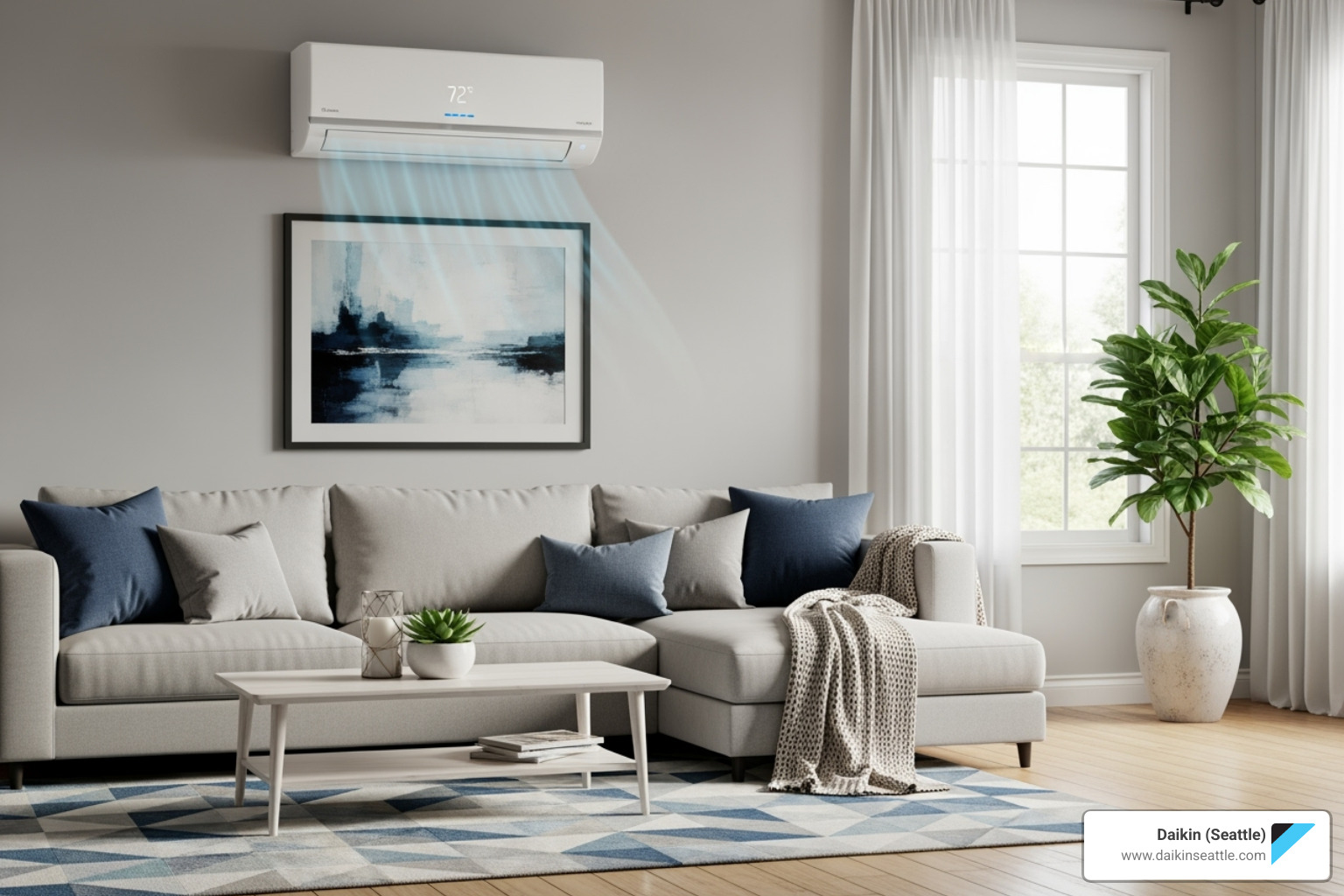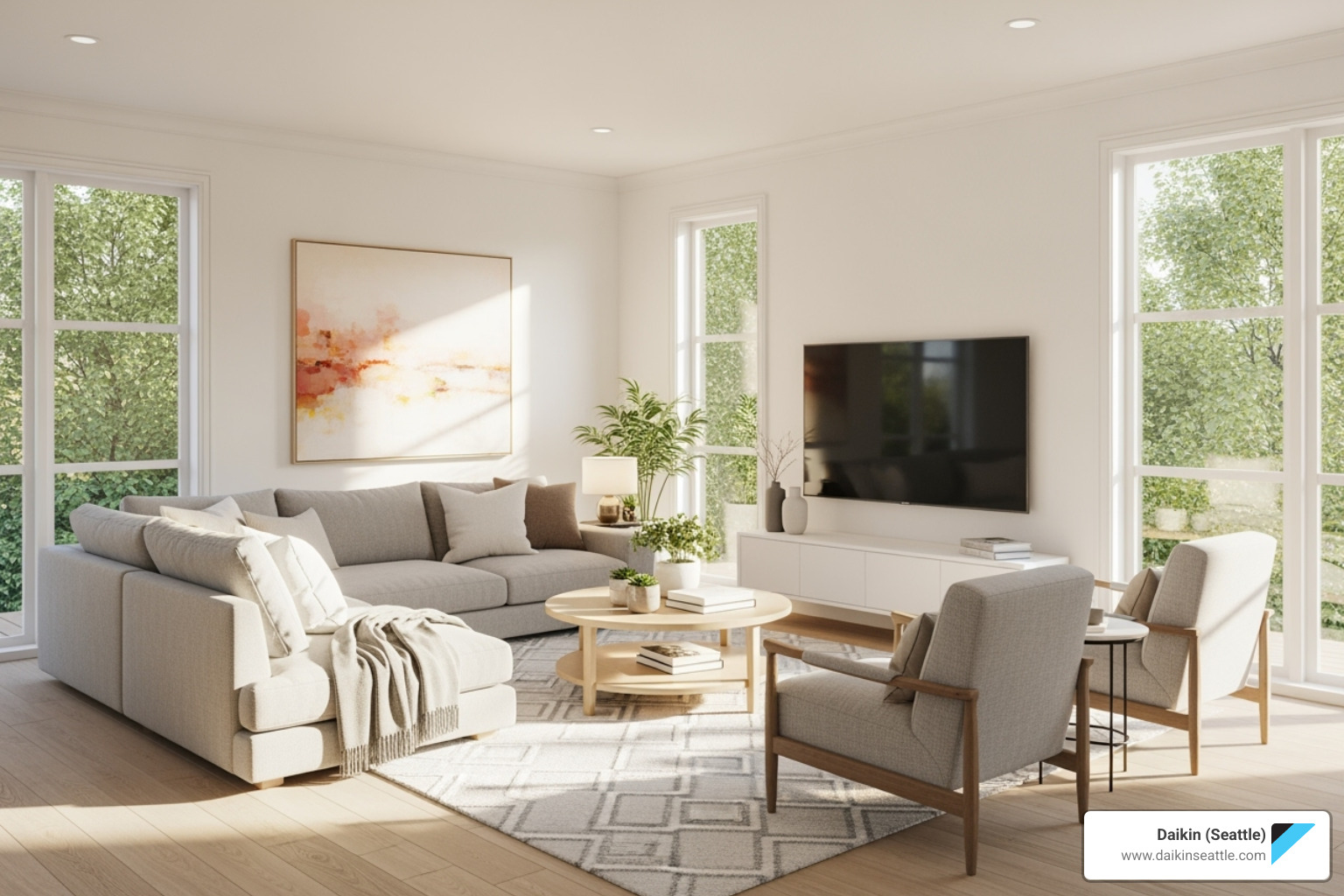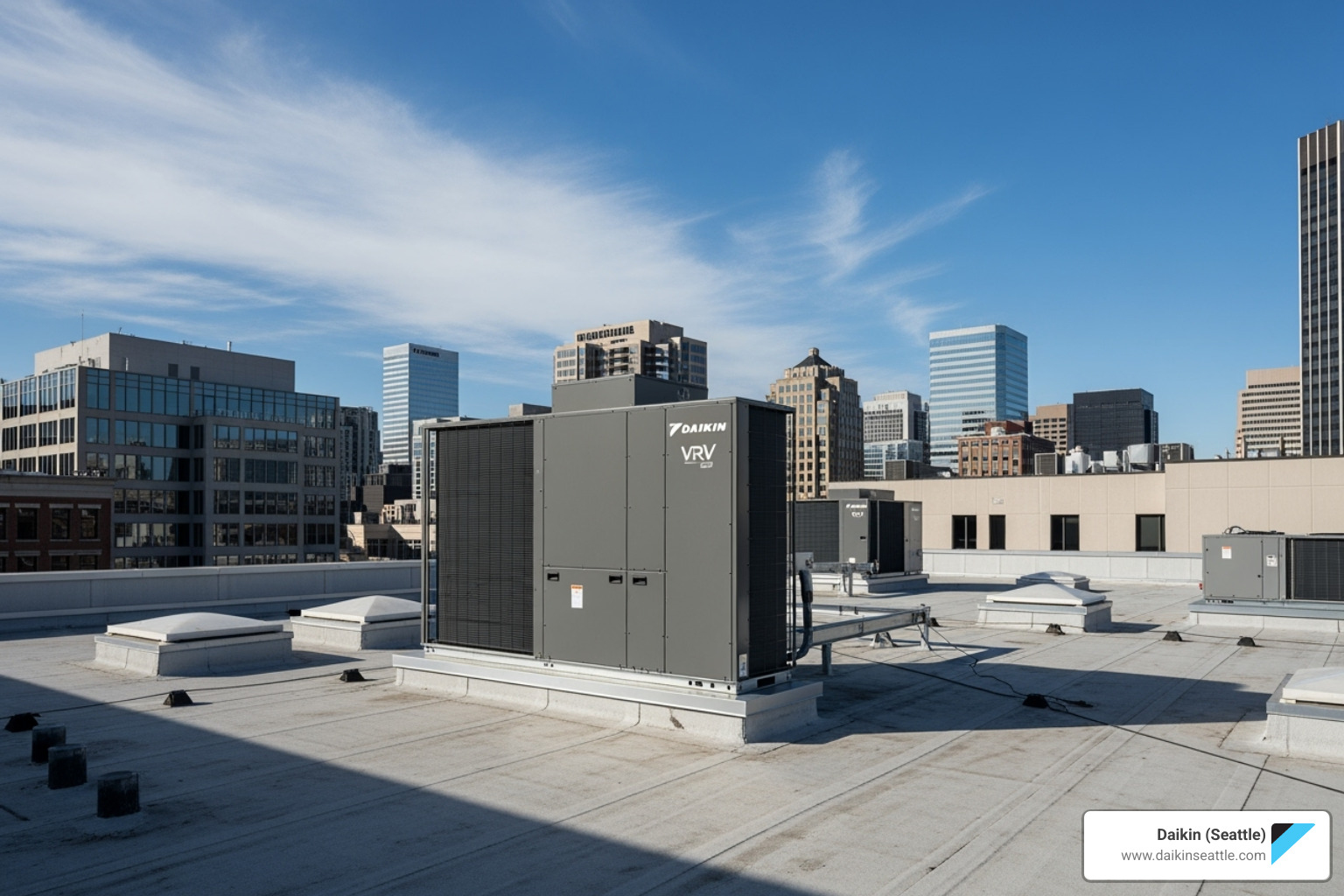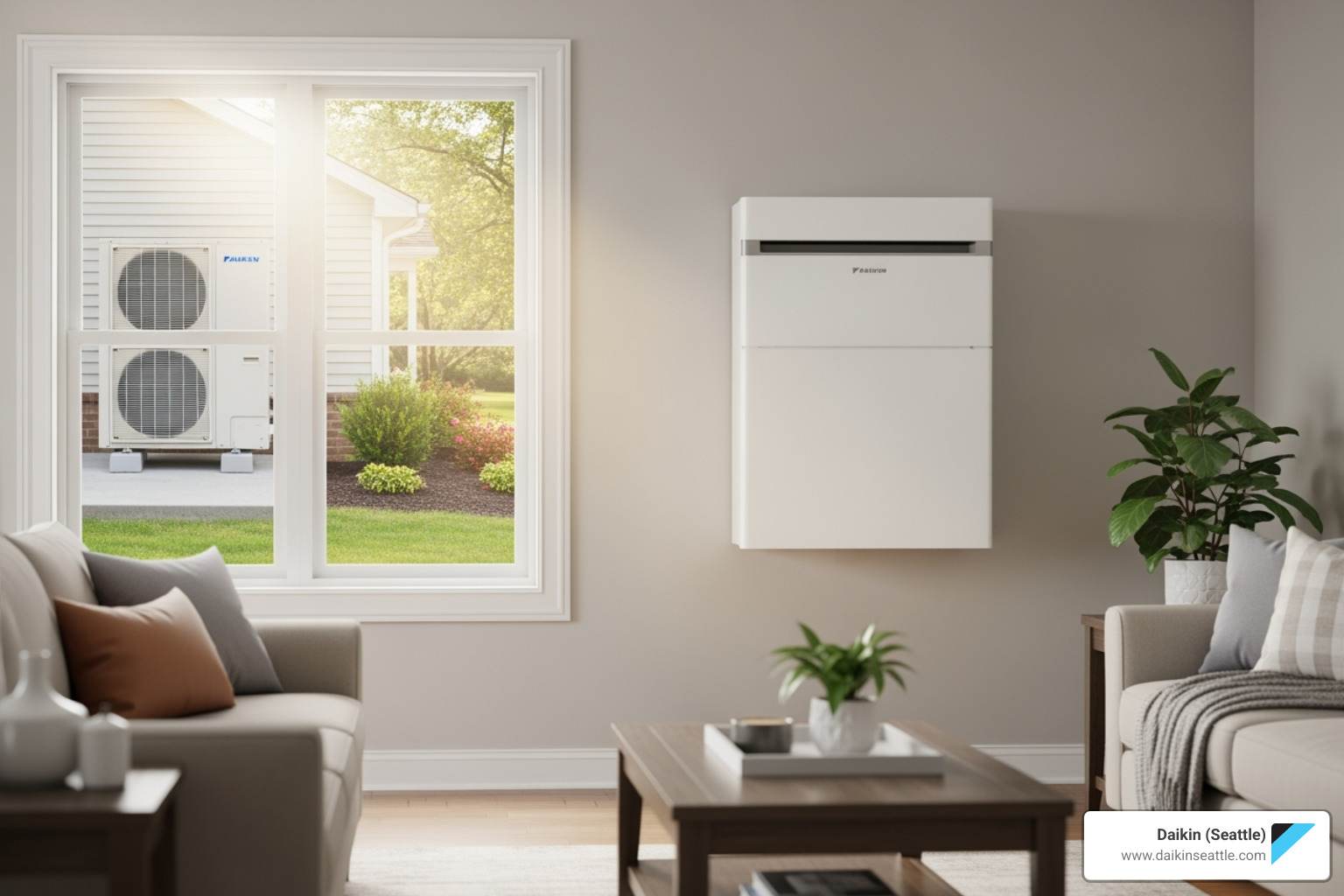Why Ductless AC Benefits Are Changing Home Comfort
Ductless AC benefits are revolutionizing home comfort for Pacific Northwest homeowners. These innovative systems, also called mini-splits, offer a smarter alternative to traditional ducted HVAC, eliminating energy waste and providing precise temperature control.
Key Ductless AC Benefits:
- Energy Efficiency: Save up to 30% on energy costs by eliminating ductwork losses
- Zone Control: Set different temperatures in each room for personalized comfort
- Improved Air Quality: Multi-stage filters remove dust, allergens, and pollutants
- Quiet Operation: Whisper-quiet performance as low as 19 decibels
- Easy Installation: Minimal disruption with no ductwork required
- Dual Function: Both heating and cooling in one system
- Long Lifespan: Last 20-30 years with proper maintenance
A ductless system has an outdoor compressor connected to one or more indoor air handlers via a small conduit. This setup delivers conditioned air directly to each room, avoiding the energy loss common in traditional ductwork.
The growing popularity of these systems is clear, with the U.S. mini-split market experiencing 221% growth over the past seven years. The beauty of ductless systems is their efficiency. Instead of conditioning an entire home through leaky ducts—which can waste over 30% of your energy—mini-splits deliver comfort exactly where you need it.
Ductless Mini-Splits vs. Central Forced-Air Systems
Choosing between a ductless mini-split and a traditional central air system? Both keep you comfortable, but they use very different approaches. Central air is an “all or nothing” system, pushing conditioned air through ducts to every room, meaning you cool the whole house even if you only need it in one room. In contrast, a mini-split gives you the freedom to condition only the spaces you’re using, a key ductless AC benefit.
| Feature | Ductless Mini-Splits | Central Forced-Air Systems |
|---|---|---|
| Installation | Minimally invasive, requires a small hole (2-3 inches) for conduit lines. Ideal for homes without existing ducts. | Requires extensive ductwork installation, which can be disruptive and costly, especially in older homes. |
| Energy Efficiency | Highly efficient due to no duct loss (up to 30% energy saved). Uses inverter technology for precise cooling/heating. | Energy can be lost through leaky ducts (up to 30% of conditioned air). Less precise temperature control. |
| Zoning Capability | Excellent, allows individual temperature control for each indoor unit/zone. | Limited, typically cools or heats the entire home uniformly, or requires complex and expensive zoning modifications. |
| Upfront Cost | Can have a higher initial equipment cost per unit, but overall installation can be cheaper if no ductwork is needed. | Lower equipment cost for a single unit, but installation cost increases significantly with ductwork. |
| Aesthetics | Indoor units are visible (wall-mounted, floor-mounted, ceiling cassettes); some concealed options available. | System is largely hidden within walls and ceilings, with only vents visible. |
Installation with central air can be messy and disruptive. Ductless systems are much simpler: we drill a small hole, run the lines, and you’re done. This makes them ideal for older homes without existing ductwork or for home additions.
Energy efficiency is a major advantage. Traditional ducts can leak up to 30% of conditioned air. Ductless systems deliver air directly with no loss. Their inverter technology also adjusts power based on demand, unlike traditional systems that cycle on and off.
Zoning capability is a game-changer. Each indoor unit operates independently, so everyone can set their own perfect temperature without compromise.
While indoor units are visible, modern designs are sleek, and some models can be concealed. It’s a small aesthetic trade-off for the flexibility and efficiency you gain. For homes without existing ductwork, installing new ducts can be more expensive than a complete ductless system, making mini-splits the clear economical choice.
Want to dive deeper into the technical details? Check out How Ductless Mini Split Systems Work or explore our comprehensive comparison at Ductless vs Ducted Systems.
The Unbeatable Ductless AC Benefits for Your Home
Ductless mini-split systems are a smart choice for modern home comfort, offering a multitude of ductless AC benefits that traditional systems can’t match. Let’s dig into what makes them so appealing.
1. Superior Energy Efficiency and Lower Utility Bills
A compelling ductless AC benefit is exceptional energy efficiency, leading to significant savings on your monthly utility bills. Traditional systems can lose over 30% of their energy through ductwork. Ductless systems avoid this by delivering conditioned air directly into the room. The U.S. Department of Energy confirms that ductless systems avoid energy losses associated with ductwork.
Modern ductless systems use advanced inverter technology, which adjusts the compressor’s speed to match heating or cooling needs. This leads to lower energy use and impressive SEER ratings up to 42. ENERGY STAR-certified systems can translate to up to 40% savings on energy costs.
2. Personalized Comfort with Zone Control
Zone control is a remarkable ductless AC benefit that allows everyone in your home to be perfectly comfortable. Unlike central systems, mini-splits let you set different temperatures in different rooms, or “zones.” You can also turn off units in unused rooms to save energy, eliminating the hot and cold spots common with traditional HVAC.
This feature is perfect for rooms that are hard to heat or cool, like a bonus room over a garage. Our multi-zone systems connect multiple indoor units to one outdoor compressor for ultimate flexibility. We offer both multi-zone and single-zone solutions to meet your needs.
3. Improved Indoor Air Quality: A Healthy Ductless AC Benefit
Indoor air quality is crucial for health, and this is another significant ductless AC benefit. Traditional ductwork can accumulate dust, mold, and allergens, which are then circulated through your home. Since ductless systems have no ducts, they eliminate this problem.
Modern ductless units feature multi-stage filtration systems that trap microscopic particles like dust, pollen, and bacteria. This provides cleaner, healthier air, which is a major plus for anyone with allergies or asthma.
Some advanced systems include features like enzyme-treated filters or UV-C light for further air purification. As noted by resources like Angi, clean air is a cornerstone of a comfortable home.
4. Quiet and Unobtrusive Operation
Tired of noisy air conditioners? The quiet operation of ductless systems is a highly appreciated ductless AC benefit. Ductless indoor units run whisper-quietly, with sound levels as low as 19 decibels—comparable to rustling leaves. The outdoor units are also much quieter than traditional central AC units, keeping your indoor and outdoor spaces peaceful. This quiet performance comes from their inverter-driven compressors that operate smoothly, avoiding the loud cycling of older systems.
5. Flexible and Fast Installation
A practical ductless AC benefit is the easy and fast installation. Because they don’t require ductwork, installation is minimally invasive. Our technicians drill a small 2- to 3-inch hole in an exterior wall to connect the indoor and outdoor units. This means no major renovations or disruption to your home.
Installation can often be completed in a single day, making ductless an ideal solution for:
- Older homes: Many older PNW homes lack ductwork, making central AC installation complex and expensive. Ductless systems offer a modern solution without compromising historic integrity.
- Home additions: Extending existing ductwork for a new room or converted garage can be difficult. A ductless unit provides easy, independent climate control.
- Targeted cooling/heating: A single ductless unit can provide precise comfort for specific areas like basements or home offices without affecting the rest of the house.
Our expertise ensures a smooth installation. For more information, see our page on Ductless Mini Split Systems in Renton.
What to Consider: Potential Drawbacks and Aesthetics
While we love sharing the amazing ductless AC benefits, we also believe in being completely honest. These systems are fantastic, but there are a few things worth considering before you make your decision.
Upfront Cost and Finding an Installer
The initial equipment cost for a ductless system can be higher than for a traditional central air conditioner. However, it’s important to put this cost into perspective. If your home lacks ductwork, as many older PNW homes do, installing a central system requires adding it. This process is disruptive and expensive, often making the total project cost for central air higher than for a ductless system.
Ductless systems save you money in the long run. The energy savings—a key ductless AC benefit—add up on your utility bills. With potential savings up to 40% on heating and cooling, the system can pay for itself over time.
Professional installation is essential. These systems require specialized knowledge for proper sizing, refrigerant handling, and electrical work. Improper installation negates the energy-saving benefits. Resources like Angi can provide helpful cost data to guide your decision.
Aesthetic Considerations and Unit Placement
Unlike hidden central air systems, ductless indoor units are visible. It’s understandable that some homeowners worry about aesthetics. The good news is that today’s units are sleek and modern, with several style options to fit your space and preferences.
- Wall-mounted units are popular, compact, and mount high on the wall.
- Floor-mounted units are great for rooms with limited wall space.
- Ceiling cassette units install flush with your ceiling for a seamless look.
- Concealed units are installed within ceilings or walls, with only small grilles visible, delivering all the benefits of ductless technology.
Our team helps homeowners find the perfect balance between performance and aesthetics. We can help you choose a style that complements your home’s design. If you’re in the Bellevue area, learn more about our customized solutions.
Advanced Features of Modern Ductless Systems
Modern ductless AC benefits extend far beyond temperature control, incorporating smart technologies that make your home more comfortable, efficient, and convenient than ever before.
All-in-One Heating and Cooling
A key ductless AC benefit is that most systems provide both heating and cooling in one unit, thanks to heat pump technology. A heat pump doesn’t create heat; it moves it. In summer, it pulls heat from your home and moves it outside. In winter, a reversing valve flips the process, pulling heat from the outdoor air to warm your home.
Even when it’s freezing, there is still heat energy in the air. Modern ductless heat pumps are engineered to extract this heat efficiently, even in temperatures well below freezing. This dual functionality is highly energy-efficient for heating compared to furnaces or baseboard heaters. For our Pacific Northwest climate, this means year-round comfort and efficiency. You can learn more from Natural Resources Canada’s information on ductless heat pumps.
Smart Technology and Sensors
Modern ductless systems have acceptd the digital age with smart features that offer incredible convenience. Wi-Fi connectivity is standard on many models, allowing you to control your system from anywhere with a smartphone app. You can set programmable schedules that learn your routine, ensuring comfort when you’re home and saving energy when you’re not.
The real magic happens with advanced sensor technology. Some systems feature sophisticated sensors that detect where people are in a room and adjust airflow accordingly. Imagine your system noticing you’ve moved from the couch to your desk and automatically redirecting the air to keep you comfortable. These sensors can also identify hot and cold spots, making micro-adjustments for even temperature distribution. It’s a personal climate assistant that optimizes comfort and maximizes efficiency—an impressive ductless AC benefit.
Frequently Asked Questions about Ductless AC
When we talk to homeowners about ductless systems, certain questions come up again and again. We love these conversations because they help us share the real-world ductless AC benefits that matter most to families. Let’s explore the questions we hear most often.
How long do ductless mini-split systems last?
Ductless mini-split systems are built to last. While a typical central HVAC system lasts about 15 years, a well-maintained ductless system can provide comfort for 20 to 30 years. This impressive longevity is a key ductless AC benefit that adds significant long-term value. The secret to reaching that 30-year mark is regular maintenance, which ensures decades of reliable service.
What kind of maintenance does a ductless system require?
Ductless systems are remarkably low-maintenance, another practical ductless AC benefit. The most important DIY task is filter cleaning. The reusable filters need to be washed every few months. Simply pop the filter out, rinse it, let it dry, and slide it back in.
We also recommend annual professional tune-ups. A technician will check refrigerant levels, clean the coils, inspect connections, and ensure peak efficiency. They will also check the condensate drain and ensure the outdoor unit is clear of debris. This simple routine ensures your system runs smoothly and efficiently.
Are ductless systems a good choice for the Pacific Northwest?
Absolutely! Ductless systems are a perfect match for the Pacific Northwest climate. Our region’s moderate summers and damp, chilly winters are ideal for modern ductless heat pumps. They provide cool relief during heat waves and efficient warmth during our mild winters. Their humidity control is also valuable for managing our region’s common moisture.
Zoned heating and cooling is another reason they shine here. Many older PNW homes lack ductwork, and adding it can be a nightmare. Ductless systems provide modern comfort without major renovations. The energy efficiency aspect also resonates with Pacific Northwest values. Our region’s focus on sustainability aligns with the reduced energy consumption these systems provide. Whether you’re in a Seattle craftsman or a modern home with an addition, ductless systems adapt to our unique housing styles and climate needs.
Conclusion: Is a Ductless System Right for You?
After exploring the many ductless AC benefits, you may wonder if this technology is right for your home. Ductless mini-splits offer a blend of efficiency, control, and convenience that traditional systems can’t match.
The energy savings are impressive—up to 30% by eliminating leaky ducts. Add zone control that lets everyone choose their own temperature, and you have a system that adapts to your lifestyle.
Ductless systems are ideal for:
- Older homes without existing ductwork: A common situation in the Pacific Northwest, you get a clean, efficient installation without the mess of installing ductwork.
- Home additions and converted spaces: A ductless unit provides independent climate control for a new workshop, basement, or sunroom without overloading your existing HVAC.
If you value energy efficiency and sustainability, these systems are a perfect fit. Their high SEER ratings and heat pump technology reduce your carbon footprint and your utility bills. The quiet operation and improved air quality are bonuses homeowners quickly love. You get clean, comfortable air without the noise and dust of traditional systems.
At Daikin Seattle, our Pacific Northwest Daikin Experience Center lets you see and feel the difference our heat pumps and inverter technology make. You can experience the quiet operation and precise control firsthand. The Pacific Northwest climate is ideal for ductless heat pump technology, providing efficient cooling in our moderate summers and effective heating in our mild winters.
Ready to see what ductless AC benefits can do for you? We can help find the perfect solution for your needs and our climate. Contact us to learn more about a ductless air conditioner in Seattle and start your journey to better home comfort.











